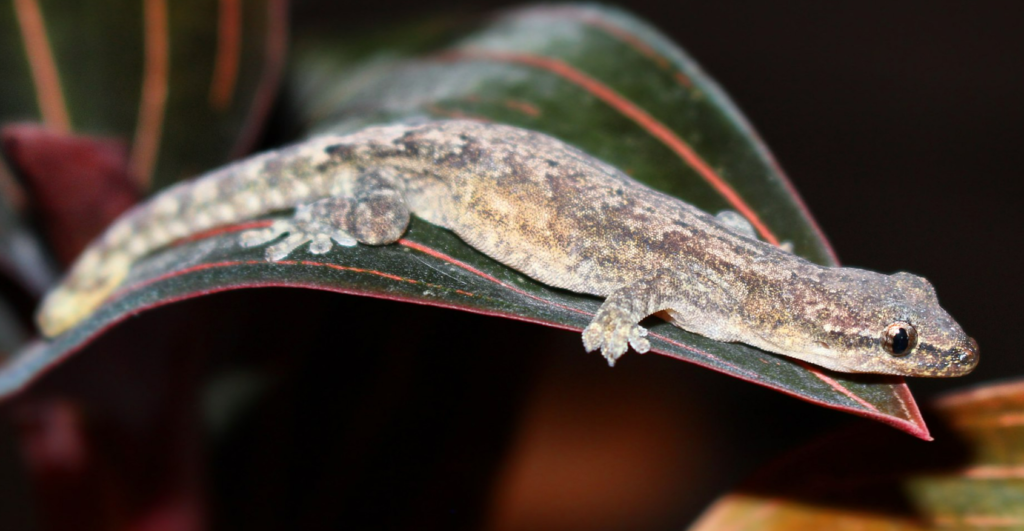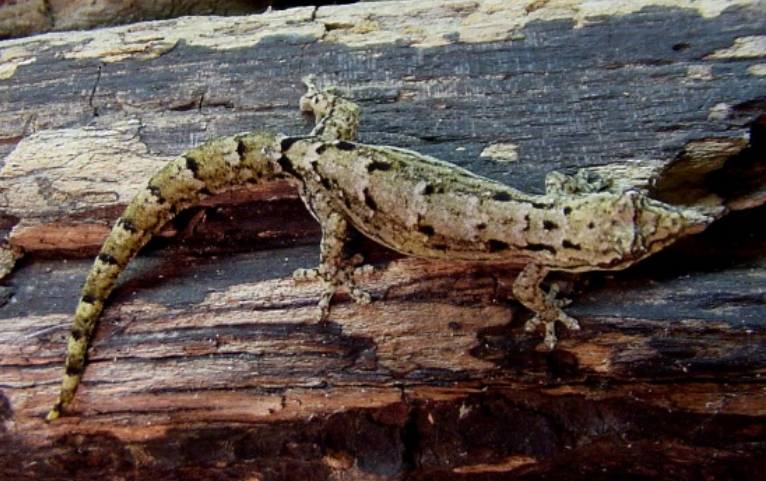Did you know that there is a species of lizard that is commonly known as the mourning gecko? This interesting creature can be found throughout much of Southeast Asia, and it has some fascinating features that set it apart from other types of lizards. In this blog post, we will take a closer look at the mourning gecko and learn more about this unique species!
The mourning gecko or common smooth-scaled gecko, Lepidodactylus lugubris, is a species of lizard belonging to the Gekkonidae family.
The Mourning gecko (Lepidodactylus lugubris) is 8.5-10 cm long, including the tail (4 – 4.4 cm snout to vent).
These clever creatures are capable of changing their color to suit the situation. They typically have dark spots down their backs and a brown strip that runs from ear-to nose tip, but some individuals may be light in appearance at different times during daytime hours!
The mourning gecko is cryptically colored, usually light to dark tan with black marks down the length of its back and a brown band from the ear to the end of the nose. This species has color-changing abilities, so the same individual may appear light or dark at various times during the day.
Ecology & Behaviour
The mourning gecko (L. lugubris) is mostly nocturnal, but it may be seen exposed during the day near cover.
The mourning gecko is a species of female-only parthenogenetic reproduction. While males do exist, they are unusual and often sterile. Every 4-6 weeks, females lay one to two eggs at a time, which they then glue to surfaces in safe locations. Clutches are produced every four to six weeks.
Distribution
The mourning gecko (Lepidodactylus lugubris) is a colorful creature that can be found all over the Indian and Pacific oceans. They are primarily distributed throughout Indonesia, Malaysia (including Singapore), Thailand, Cambodia, Japan, Sri Lanka, Philippines, Papua New Guinea, Fiji, Australia (Cocos Island), Guam and Western Samoa just to name a few.

Lepidodactylus lugubris has been widely introduced in the Neotropics, including Mexico, Brazil, Guatemala, Honduras, El Salvador, Nicaragua, Costa Rica, Panama, Ecuador (including the Galapagos), Colombia and Chile. It has also been introduced to the Seychelles in the Indian Ocean.
Mourning gecko diet
Mournful geckos (L. lugubris) are omnivores that feed on a variety of food in the wild, including insects, fruit, and pollen.
Mourning gecko as pet, in captivity
The L. lugubris (mourning gecko) is a popular pet because of its simple care demands and sociable disposition. These geckos are parthenogenic, which means they reproduce effectively in captivity, resulting in most pets being captive-bred.
GGA Mourning Gecko Care Sheet
GGA Cares For…. Lepidodactylus lugubris (Mourning gecko)
Reprinted from “Chit Chat” the Newsletter of the Global Gecko Association #7 ©2001
Common Name: Mourning gecko
Scientific Name: Lepidodactylus lugubris (Dumeril & Bibron, 1836)
Description
Lepidodactylus lugubris are small geckos of approximately snout-vent length (SVL) 45mm, although the maximum SVL can vary slightly according to the population from which the animal comes. The tail is moderately long and normally just over 100% of SVL. The skin is smooth. Their backs and tails have a ground color of pale creamy-fawn with a variegated dark brown/beige “overlapping” zigzag pattern. They can change shades of color between white, brown, reddish-brown, fawn and gray. Their undersides are always beige and sometimes speckled. Hatchlings are miniature replicas of the adults.
Lepidodactylus lugubris has a well-developed voice and it makes a loud single-syllable chirping noise which is repeated five to ten times in quick succession and sounds something like “chik, chik, chik, chik, chik, chik, chik…” (McKeown, 1996).
These geckos are parthenogenetic which means that females reproduce independently of a male. Consequently populations are all female.
Lepidodactylus lugubris is one of approximately 25 species of Lepidodactylus and is a member of Lepidodactylus Group III (Brown and Parker 1977).
Distribution
Lepidodactylus lugubris are extremely widespread being found across the Pacific region. They can also be found in the Hawaiian Islands as well as Cocos (Keeling) Island and Queensland, Australia, Central and South America, and beyond.
Natural History
As can be guessed at by its enormous range Lepidodactylus lugubris is a very adaptable gecko that can thrive in a variety of habitats. In different geographic locations they have been found in mangrove trees, on bare rocks near seashores, in the leaf axils of palms, behind the bark of trees and in human habitations. Although nocturnal, in captivity this species is somewhat active and visible during the day.
Housing In Captivity
Lepidodactylus lugubris do well in small groups. I keep up to six in a ten-gallon vivarium and this affords the opportunity to witness social interactions among the group. Whilst a dominance hierarchy can occur and fighting will ensue this is not as severe as can happen when males of some gecko species are kept together. However, if space is too limited and hideouts too scarce I have witnessed some severe aggression with posturing (arching back) and attacking of cage mates. I have even observed a specimen upside down on the top screen biting another gecko, which was literally dangling from the attacker’s mouth! Generally though, given adequate space and cage furnishings this is a relatively sociable species and usually battle wounds heal with time.
Keep these geckos at 70°F minimum with a somewhat warmer temperature during late Spring and Summer. They do not seem to require a temperature drop at night. My personal rule of thumb is that a warm Lepidodactylus lugubris is an active Lepidodactylus lugubris! Fresh water should be available in the vivarium at all times. I use a peat moss substrate and live potted plants to assist in increasing the humidity. Generously mist at least once daily, more often if temperatures exceed 80°F. Periodically dampen the substrate but note that the environment should “dry out” by the day’s end.
Varied cage furniture adds to your geckos’ comfort, increases their activity, and adds interest from a human perspective. Provide rocks, driftwood, plastic aquarium foliage, potted plants (e.g. Pothos, Sanseveria sp.), and ample hiding places. Aquarium vines can be hung upside down with small suction cup hooks. A well-fitted fine mesh screen for the top of the vivarium is a must. These geckos are escape artists!
Food & Feeding
Shake crickets (1/4″, up to 1/2″), vestigial-winged Drosophila, waxworm larvae, and other live food with Rep-Cal’s phosphorous-free, ultrafine calcium with vitamin D3 powder and/or Sticky Tongue Farms’ Miner-all “I” powder. As an additional calcium supplement, you can also feed these geckos shaved cuttlebone. Lepidodactylus lugubris will eat cuttlebone directly from a plastic lid. As a second natural calcium supplement, be sure to “recycle” the empty eggs after the young have hatched.
These geckos enjoy a variety of baby foods (banana, peach, tropical fruit, and either chicken or turkey) once a week or so. Blend in the vitamins and place the mixture on a plastic lid. Balance the amount of vitamin A judiciously, because vitamin A toxicity can be a problem.
To reduce decay from cricket carcasses inside the tank, some gecko-keepers place crickets in a separate container within the vivarium. These geckos will readily climb into this container for their meals. If you try this feeding technique a word of caution; sometimes excess powder falls off the crickets into the container, “sticks” to the geckos’ toes and makes the geckos temporarily unable to climb out!
Health
Contrary to what Henkel and Schmidt (1995) imply, Lepidodactylus lugubris can be cannibalistic. They will consume the yolk or the embryo if an egg happens to crack prematurely. I have also occasionally witnessed them pursuing and consuming unlucky hatchlings. I therefore recommend the removal of hatchlings as soon as they are discovered within the parent vivarium.
Tails regenerate if bitten off. Fingers and toes will not regenerate. If skin remains after shedding, your gecko will need some assistance in removing the skin or digits may be lost. Soak your gecko in tepid water, and then carefully remove loosened skin with tweezers. Peat moss used as a substrate increases the humidity when sprayed, thereby lessening incomplete sheds. Seizures may result if calcium and vitamin supplementation is less than optimal. Kinked tails may be indicative of excess vitamin A.
These attractive animals do not seem to mind being handled. Longevity seems to be in their genes – I have one specimen that is 12 1/2 years old.
Breeding
At about eight to ten months old Lepidodactylus lugubris become sexually mature. They generally lay two eggs, but occasionally one egg, per clutch and they are prolific, communal egg-layers! They will “glue” their hard-shelled eggs almost anywhere. Once laid, the eggs are very difficult to remove without cracking. I suggest placing a section of choya wood, bamboo, or plastic aquarium foliage in the tank as potential portable egg-laying sites that can be removed, together with eggs, for incubation. Eggs take 60 days or longer to hatch when kept at a minimum of 70°F. Hatchlings measure 35mm from snout to tail tip at birth and are easy to raise.
GGA Rating (1-4): 1, meaning “Ideal for beginners”.
Recommended Mourning Gecko Reading
Bauer, A.M. and R.A. Sadlier. 2000. The Herpetofauna of New Caledonia. SSAR. 310pp.
Brown, W.C. and F. Parker. 1977. Lizards of the genus Lepidodactylus (Gekkonidae) from the Indo-Australian Archipelago and the islands of the Pacific, with description of new species. Proc. California Acad. Sci. 41:253-265
De Vosjoli, Philippe. 1994 The Lizard Keeper’s Handbook. Advanced Vivarium Systems Inc.; Lakeside, California. 175 pp.
Henkel, F-W. and W. Schmidt. 1995 Geckoes: Biology, Husbandry, and Reproduction. Krieger Publishing Company; Malabar, Florida. 237 pp.
McKeown, S. 1996. A Field Guide to Reptiles and Amphibians in the Hawaiian Islands. Diamond Head Publishing, Inc. Los Osos, California. 172 pp.
Seufer, Hermann. 1991. Keeping and Breeding Geckos. T. F. H. Publications, Inc.; Neptune, New Jersey. 191 pp.
Author: Elizabeth Freer.
The care sheet for mourning geckos above has been restored from the original Gekkota website. If you as a author have any comments about us retoring it on our website, please contact us.
Mourning gecko fact sheet
| Conservation status | Least Concern |
| Kingdom | Animalia |
| Phylum | Chordata |
| Class | Reptilia |
| Order | Squamata |
| Family | Gekkonidae |
| Genus | Lepidodactylus |
| Species | L. lugubris |
| Common name(-s) | Mourning gecko or common smooth-scaled gecko |
| Binomial name | Lepidodactylus lugubris,(Duméril & Bibron, 1836) |
Summary
Mourning geckos are a species of lizard that can be found in the Indo-Australian Archipelago and the Pacific islands. They are easy to care for and breed, and make ideal pets for beginners. If you are considering adding a mourning gecko to your home, be sure to do some research on their care and habitat requirements first. Thanks for reading!
I hope you enjoyed this article on mourning geckos. If you have any questions or comments, please feel free to leave them below. And be sure to check out our other articles on reptiles and amphibians!
Thanks for reading!
